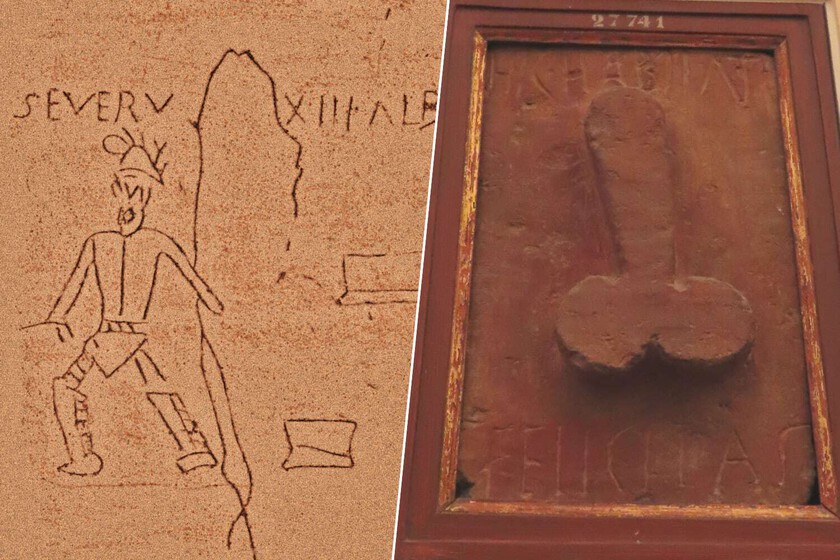“We’ve been fooled” or “vampires exist” are not only two examples of graffiti culture, but also a perpetual manifestation of an individual’s thoughts at a given moment. In any city in the world we find graffiti on a wall that can range from the most incredible work of art we have ever seen to a brief phrase that has the potential to be discovered by the Internet and turned into a meme.
I’m sure the person who wrote “please don’t laugh at retarded people” thinks he’s crazy, but neither he nor Banski have invented anything: for thousands of years, mankind has been putting its art and thoughts on other people’s walls. The first graphic representation of Jesus Christ was graffiti, and even the Mayans made graffiti, to give two examples that are several thousand years old.
The Pompeian figures, however, are worthy of a full course in the History of Art course, as they tell us about a society and its vital issues. And above all, they show us that sex and eroticism were so important that they pushed the Pompeians to quickly express their thoughts on the first wall they found. As the studies say, we have not changed at all in 2,000 years.
Spite, love or various banalities
August Always He was a German art historian and archaeologist who became obsessed with Pompeii. If there was one good thing about Vesuvius (one might say, since there are no 2,000-year-old Pompeians who could be offended) it was that many of the structures, murals and other elements were left in perfect condition so that, centuries later, we could discover what life was like in both Pompeii and Herculaneum.
Every so often we discover rooms with paintings, period items and even burnt papyri that we are ‘unrolling’ thanks to the latest technology. Mau became obsessed with Pompeii and devoted himself, above all, to the study of both the inscriptions and the mural paintings. Thus, he published his ‘Pompeii: It’s Life and Art’, which still has academic validity, a book in which he expressed his research.
However, among murals and so on, Mau came across something he didn’t like and that he could burst the bubble of Pompeian idealization as a model user, cultured and immaculate. We are talking about graffiti, something that Mau denies and that description as follows:
“Taken as a whole, the graffiti are less fruitful for our knowledge of Pompeian life than might have been hoped. The people with whom we would most long to have direct contact, the cultured men and women of the ancient city, were not accustomed to scratching their names into stucco or confiding their reflections and experiences on the surface of a wall… We may assume that the writers were as unrepresentative of the better elements of society as are today the tourists who scratch or carve their names on ancient monuments.”
I am not going to be the one to contradict Mau, but precisely those more than 11,000 graffiti They are what bring us closer to the Pompeian of 2,000 years ago because they allow us to know the concerns of ordinary men and women. In the different research In various houses, both in Pompeii and Herculaneum, have been found numerous graffiti reflecting the concerns of the average Pompeian.
Any wall was a bulletin board that allowed any individual to talk about their interests, but was also used as a canvas for marketing. And, fortunately, examples there are plenty:
- “The troop of gladiators of Aulus Suecio Certo will fight in Pompeii on May 31. There will be a hunt and tents.”
- “Gaius Pumidios Diphilus was here.”
- “Pyrrhus to his companion Quas: I am sorry to hear that you are dead, and therefore, farewell!”
- “Secundus greets his fellow slaves with pleasure on their departure.”
That is, it was a mix between bulletin boards and WhatsApp statuses and the curious thing is that it is estimated that there were food or accommodation establishments that had reviews on the walls. In the absence of Google Maps, a wall is good:
- “Host, we wet the bed. I admit it. If you want to know why: there was no potty.”
- “Emperor Nero’s financial official declares that the food here is poisonous!”
- “We came here with nostalgia. Now we want to leave as quickly as possible!”
- “Gaius Sabinus affectionately greets Statius. Traveler, in Pompeii they eat bread, but in Nuceria they go to drink. In Nuceria they drink better.”
- “I hope you pay for all your tricks, innkeeper. You sell us water and you keep the good wine.”
- “Adifidius was here. Hades”.
There were also jokers who wrote a “Whoever reads this is crazy!” knowing that the texts on walls must be read aloud and there were many, many graffiti dedicated to support Nero. He is not the Roman emperor who has gone down in history as one of the best, but of the 100 graffiti intended to praise different emperors, more than half were for Nero.
And for some strange reason, in Pompeii they were also very concerned about not stepping in their own shit. Or rather, their shit. Apart from warnings – “you who shit here, be careful not to have an accident” – there were various demonstrations of people saying “I shit here” or something as specific as “Girl, we’re going to have a great time shitting here.”
And some other romantic ones, like the poem in the upper engraving, which says:
Oh, if I could just wrap your little arms around my neck
and kiss your tender lips!
Go, little doll, entrust your happiness to the winds.
Cream, the nature of men ( c ) is fickle.
I often lay awake, lost in the middle of the night,
thinking to myself: Many whom Fortune has raised on high,
those, suddenly thrown/abandoned and falling headlong, she then oppresses.
Likewise, after Venus has unexpectedly united the bodies of the
lovers,
the light of day divides them and…
Lots and lots of sex, eroticism and bragging
A fascinating thing is that thousands of years ago, when we learned to paint, one of the first things we drew on the walls was a penis. Pornography and eroticism are as old as humanity itself, and although today we want to put a stop to porn, in Pompeii it would have been completely impossible.
We remain focused on Pompeii when we say that erotic art was extremely popular in the villa. found nude sculptures, frescoes of copulating couples and mosaics depicting exactly the same thingThere were also household items decorated with sexual themes and that erotic art In Pompeii and Herculaneum it was, well, an art.
But returning to graffiti, we also have many examples of erotic or, directly, sexual phrases. But many manyAnd something extremely interesting is that there is context, like the place whose facade was used to give free rein to that poetry that we all carry within:
- Brothel of Innulus and Papilio: “Cry, girls. My penis is leaving you. Now it penetrates the men’s backsides. Goodbye, wonderful femininity!”
- Gladiator barracks: “Antiochus spent time here with his girlfriend Cytherea” (this one was even restrained). Another on the same façade: “Floronius, a privileged soldier of the Seventh Legion, was here. The women were unaware of his presence, only six of them found out. Very few for a stud like him.”
- A wall: “Tefilo, do not perform oral sex on girls against the city wall as if it were a dog.”
- House of Orpheus: “I have sodomized men.”
- Atrium of the House of Pinarius: “If anyone does not believe in Venus, look at my bride.”
- House of Merchants Vibii: “Atimetus got me pregnant.”
- He Lupinare: “I’ve fucked a lot of girls here.” She wasn’t the only one: “Sollemnes, you really do it!” or “On June 15th, Hermeros slept here with Phileterus and Caphisus.”
And there was also a lot of bragging and boasting. On many walls you can read boasts about how many times someone has had sex, who manages to seduce the most women, someone’s fellatory skills, and there are several phrases aimed at Rómula and Rufa, also related to their performance in the oral arts.
In this link We leave you a page that is fantastic, as it has compiled many of these graffiti in which we can see the neighborhood, the building, the translation and the original text.
Street art
But the Pompeians did not just stick to text messages to boast, scold or express their feelings: They also drew practically everything. Here they were more than just messages, and graffiti depicting gladiators, caricatures of people, combat scenes and drawings of ships were found. And it is quite a feat to have engraved this on a wall.
The funny thing about all this is that history has treated graffiti badly. Something with 2,000 years of history should have been studied in detail, but there are researchers who, following Based on Mau’s belief, they considered that the graffiti were not written by the type of people we would be most interested in knowing, so they were ignored for decades.
And the curious thing about those in Pompeii is that they did not evolve: all these texts show society until 79 AD. There were even haters from the graffiti: “Oh wall, you’re so covered in messages I’m surprised you didn’t collapse long ago.”
It never rains to everyone’s liking, of course.
Images | Rabakh63, Jebuln, sebastien amiet;l, Tracey Hind de Aups, Mentnafunangann
In Then13 | The orgasm is an explosion of sexual pleasure. In this historic case of medicine came with another explosive surprise

